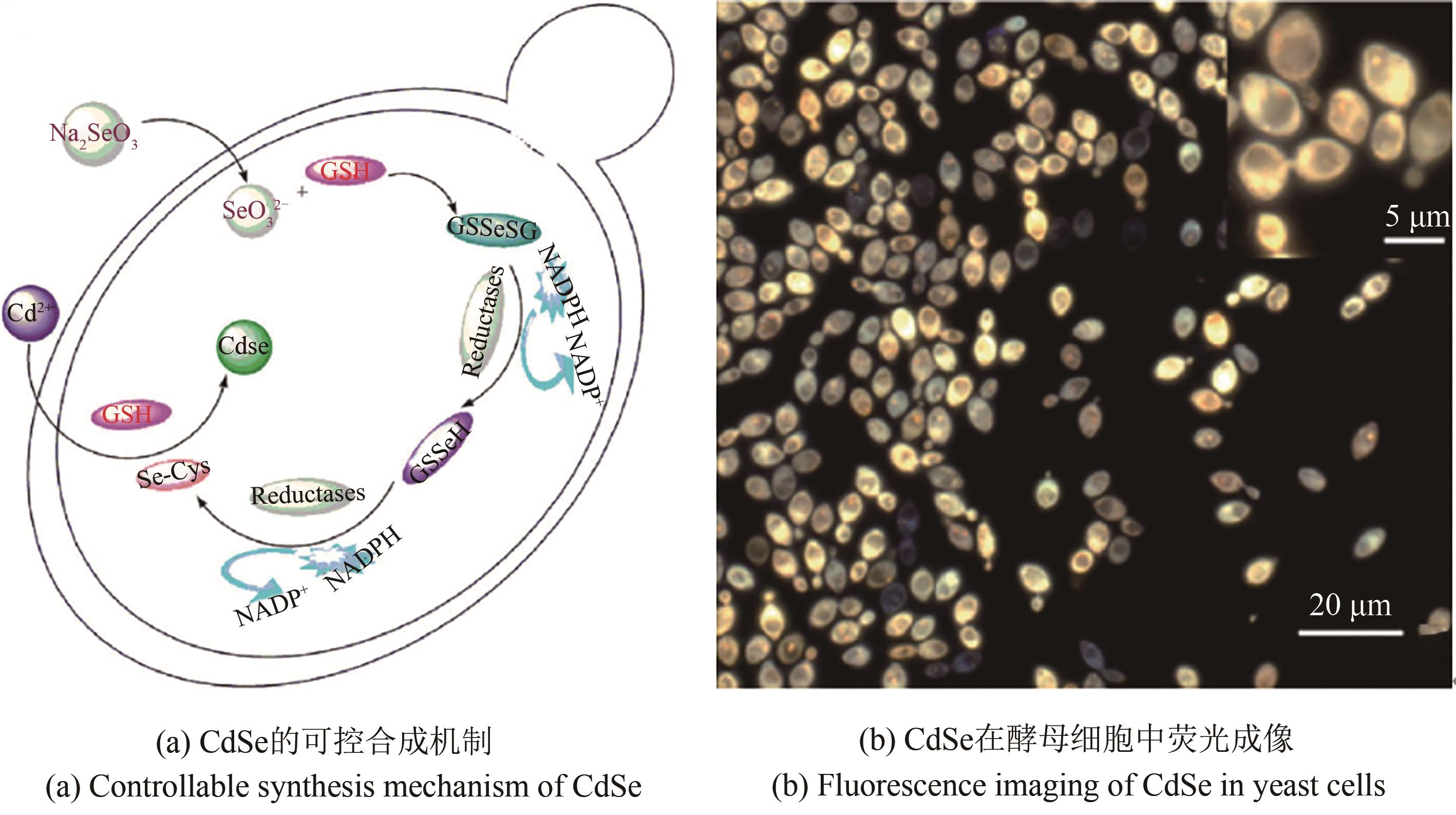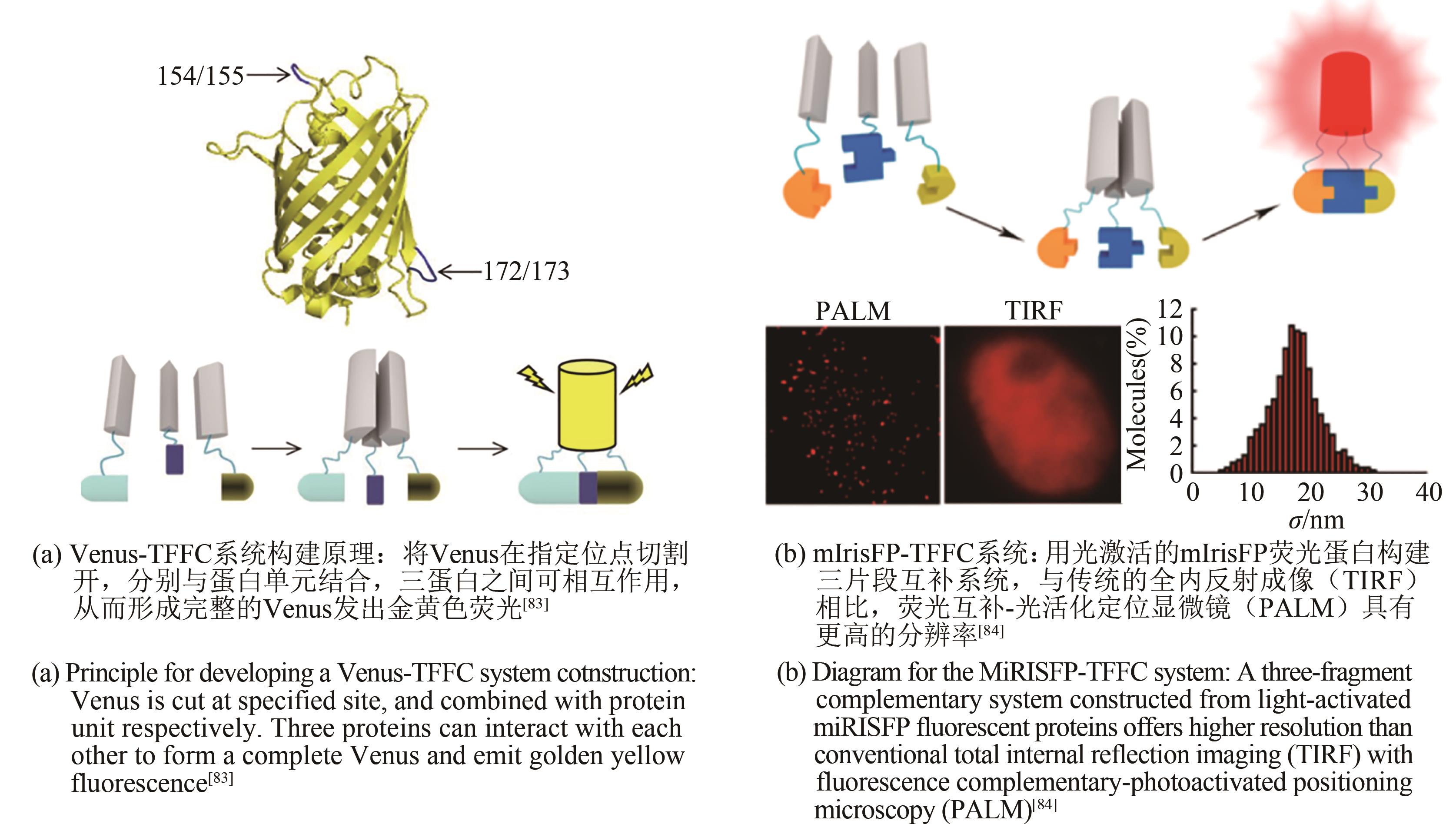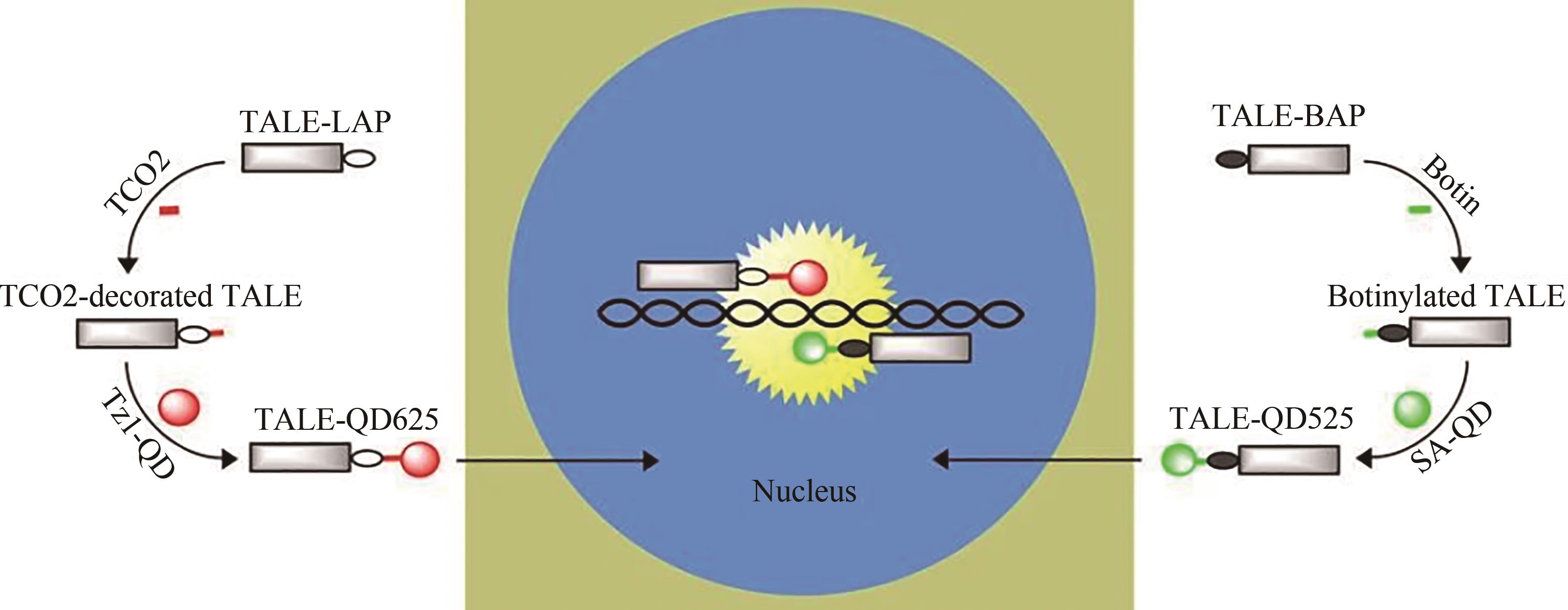Synthetic Biology Journal ›› 2022, Vol. 3 ›› Issue (2): 369-384.DOI: 10.12211/2096-8280.2021-060
• Invited Review • Previous Articles Next Articles
Synthetic biology for fluorescent bioimaging
WU Weihong1, LI Wei2, ZHANG Xian’en3, CUI Zongqiang2
- 1.Division of Life Sciences and Medicine,University of Science and Technology of China,Hefei 230026,Anhui,China
2.State Key Laboratory of Virology,Wuhan Institute of Virology,Chinese Academy of Sciences,Wuhan 430071,Hubei,China
3.National Key Laboratory of Biomacromolecules,Institute of Biophysics,Chinese Academy of Sciences,Beijing 100101,China
-
Received:2021-05-13Revised:2021-09-06Online:2022-05-11Published:2022-04-30 -
Contact:CUI Zongqiang
合成生物学与荧光成像技术
武伟红1, 李炜2, 张先恩3, 崔宗强2
- 1.中国科学技术大学生命科学与医学部,安徽 合肥 230026
2.中国科学院武汉病毒研究所,病毒学国家重点实验室,湖北 武汉 430071
3.中国科学院生物物理研究所,生物大分子国家重点实验室,北京 100101
-
通讯作者:崔宗强 -
作者简介:武伟红 (1998—),女,硕士研究生。研究方向为病毒与合成生物学。 E-mail:wuweihong@mail.ustc.edu.cn崔宗强 (1977—),男,研究员,博士生导师。研究方向为病毒学研究新技术如单病毒示踪、纳米疫苗等。创建了多种荧光纳米标记及单病毒示踪新技术,实时示踪了单个艾滋病毒、单个流感病毒脱壳过程,并实现了单拷贝艾滋病毒基因原位成像、多蛋白复合体超高分辨成像等。 E-mail:czq@wh.iov.cn -
基金资助:国家自然科学基金(31925025)
CLC Number:
Cite this article
WU Weihong, LI Wei, ZHANG Xian’en, CUI Zongqiang. Synthetic biology for fluorescent bioimaging[J]. Synthetic Biology Journal, 2022, 3(2): 369-384.
武伟红, 李炜, 张先恩, 崔宗强. 合成生物学与荧光成像技术[J]. 合成生物学, 2022, 3(2): 369-384.
share this article
Add to citation manager EndNote|Ris|BibTeX
URL: https://synbioj.cip.com.cn/EN/10.12211/2096-8280.2021-060
| 荧光材料 | 大小 | 荧光强度 | 荧光量子效率 | 荧光寿命 |
|---|---|---|---|---|
| 量子点 | 2~20 nm | +++++ | 0.1~0.85 | 20 min |
| 荧光蛋白 | 4 nm | + | 0.79 | 100 ms |
| 荧光RNA | 40 bp | +++ | 0.30~0.70 | > 15 min |
Tab. 1 Properties of different fluorescent materials [74-76]
| 荧光材料 | 大小 | 荧光强度 | 荧光量子效率 | 荧光寿命 |
|---|---|---|---|---|
| 量子点 | 2~20 nm | +++++ | 0.1~0.85 | 20 min |
| 荧光蛋白 | 4 nm | + | 0.79 | 100 ms |
| 荧光RNA | 40 bp | +++ | 0.30~0.70 | > 15 min |
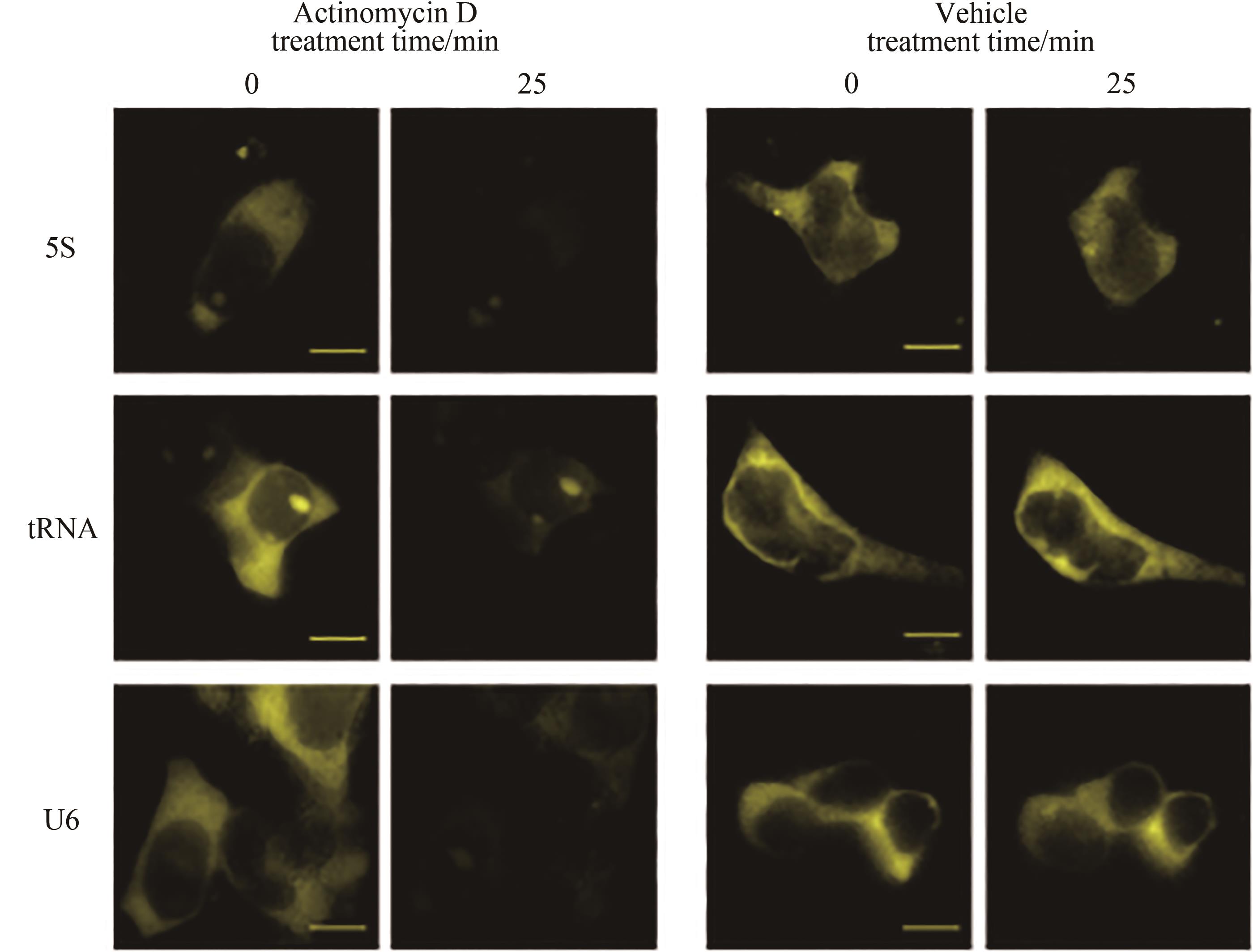
Fig. 5 Schematic diagram for imaging polymerase activity in single cells through aptamer corn fluorophore[87](HEK293T cells transformed with the reporter plasmid could produce yellow fluorescence by adding fluorophore DFHO, but the fluorescence disappears after adding the RNA polymerase inhibitor actinomycin D.)
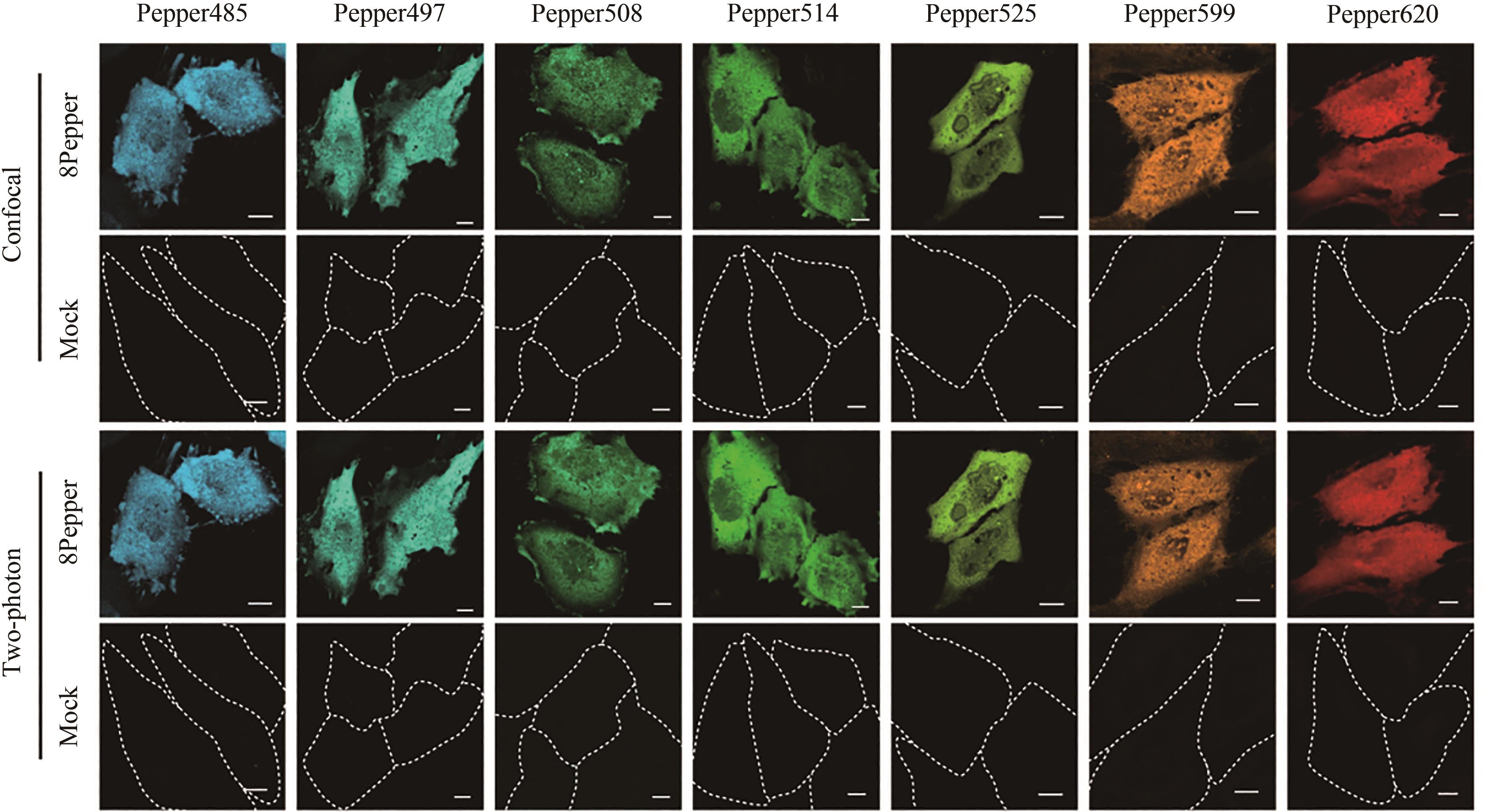
Fig. 7 Schematic diagram for imaging of the fluorescent RNA complex in HeLa cells[76](A series of analogues of synthetic dye HBC combined with Pepper can emit fluorescence with different colors. HBC analogues were combined with Pepper in HeLa cells and are compared with mock cells. Imaging observation is carried out with confocal microscope and two-photon microscope.)
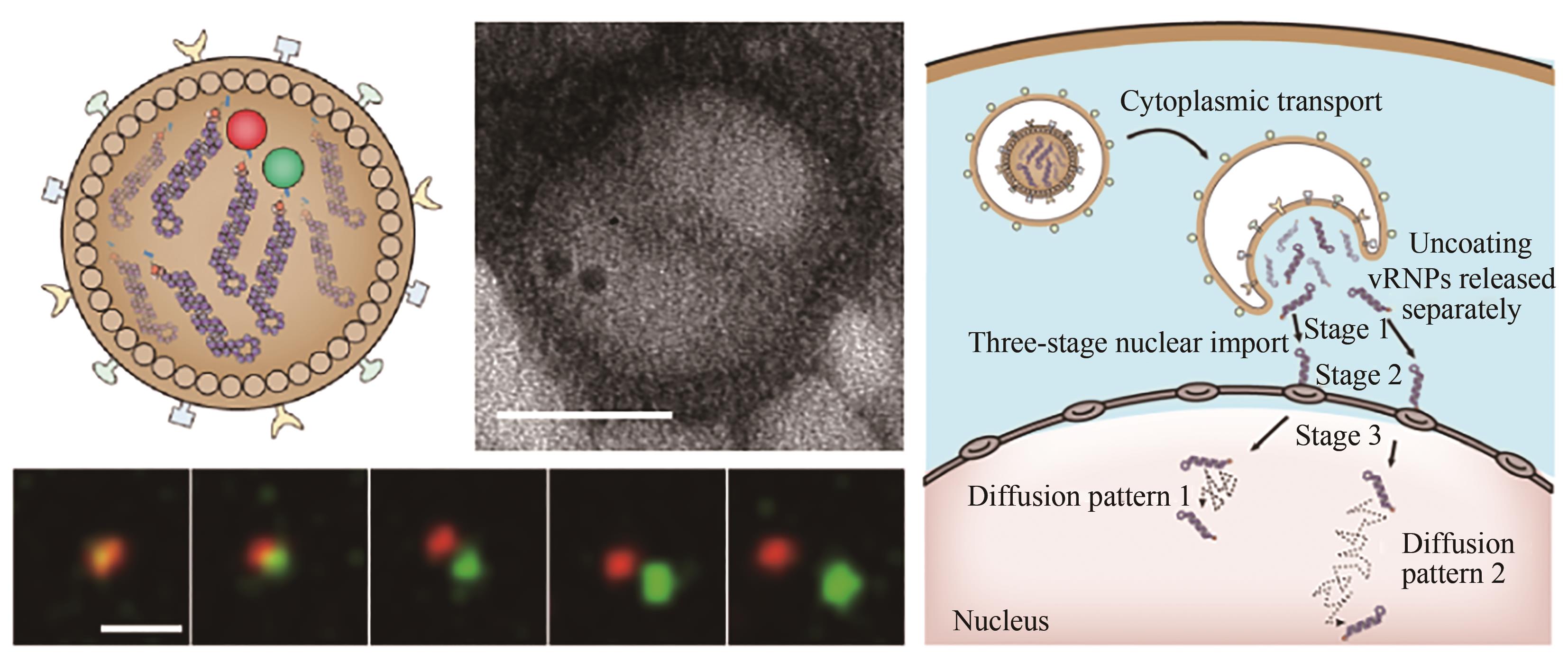
Fig. 9 Real-time dynamic tracking of the influenza virus unpacking process[75][Under electron microscope, QD625 is black and round, while QD705 is triangular. vRNP is labeled with QD625 (red) and QD705 (green) respectively, and the results showed that QD625 and QD705 are released during the hulling process, respectively. IAV-released vRNPs released from IAV reach the nucleus through a three-stage active transport, where they undergo two diffusion modes.]

Fig. 11 SV40-QD VLPs for imaging atherosclerotic plaques in targeted mice[100](SV40 VLPs contain atherosclerotic targeting units, thrombin inhibitors, which can encapsulate as QD800. FH-QDS can target atherosclerotic areas in mice.)
| 1 | BENNER S A, SISMOUR A M. Synthetic biology[J]. Nature Reviews Genetics, 2005, 6(7): 533-543. |
| 2 | PATOLSKY F, ZHENG G F, LIEBER C M.Nanowire sensors for medicine and the life sciences[J]. Nanomedicine: Nanotechnology, Biology and Medicine, 2006, 1(1):51-65. |
| 3 | CELLO J, PAUL A V, WIMMER E. Chemical synthesis of poliovirus cDNA: generation of infectious virus in the absence of natural template[J]. Science, 2002, 297(5583): 1016-1018. |
| 4 | ANNALURU N, MULLER H, MITCHELL L A, et al. Total synthesis of a functional designer eukaryotic chromosome[J]. Science, 2014, 344(6179): 55-58. |
| 5 | MERCY G, MOZZICONACCI J, SCOLARI V F, et al. 3D organization of synthetic and scrambled chromosomes[J]. Science, 2017, 355(6329): eaaf4597. |
| 6 | GIBSON D G, GLASS J I, LARTIGUE C, et al. Creation of a bacterial cell controlled by a chemically synthesized genome[J]. Science, 2010, 329(5987): 52-56. |
| 7 | FREDENS J, WANG K, DE LA TORRE D, et al. Total synthesis of Escherichia coli with a recoded genome[J]. Nature, 2019, 569(7757): 514-518. |
| 8 | SAKO Y, MINOGHCHI S, YANAGIDA T. Single-molecule imaging of EGFR signalling on the surface of living cells[J]. Nature Cell Biology, 2000, 2(3): 168-172. |
| 9 | IINO R, KOYAMA I, KUSUMI A. Single molecule imaging of green fluorescent proteins in living cells: E-cadherin forms oligomers on the free cell surface[J]. Biophysical Journal, 2001, 80(6): 2667-2677. |
| 10 | HAJIPOUR F, ASAD S, AMOOZEGAR M A, et al. Developing a fluorescent hybrid nanobiosensor based on quantum dots and azoreductase enzyme for methyl red monitoring[J]. Iranian Biomedical Journal, 2021, 25(1): 8-20. |
| 11 | DERFUS A M, CHAN W C W, BHATIA S N. Probing the cytotoxicity of semiconductor quantum dots[J]. Nano Letters, 2004, 4(1): 11-18. |
| 12 | GREEN M, O'BRIEN P. Recent advances in the preparation of semiconductors as isolated nanometric particles: new routes to quantum dots[J]. Chemical Communications, 1999(22): 2235-2241. |
| 13 | MICHALET X, PINAUD F F, BENTOLILA L A, et al. Quantum dots for live cells, in vivo imaging, and diagnostics[J]. Science, 2005, 307(5709): 538-544. |
| 14 | SCHMIDT T, SCHÜTZ G J, BAUMGARTNER W, et al. Imaging of single molecule diffusion[J]. Proceedings of the National Academy of Sciences of the United States of America, 1996, 93(7): 2926-2929. |
| 15 | DAHAN M, LÉVI S, LUCCARDINI C, et al. Diffusion dynamics of glycine receptors revealed by single-quantum dot tracking[J]. Science, 2003, 302(5644): 442-445. |
| 16 | ALIVISATOS A P, GU W W, LARABELL C. Quantum dots as cellular probes[J]. Annual Review of Biomedical Engineering, 2005, 7: 55-76. |
| 17 | LIU W H, HOWARTH M, GREYTAK A B, et al. Compact biocompatible quantum dots functionalized for cellular imaging[J]. Journal of the American Chemical Society, 2008, 130(4): 1274-1284. |
| 18 | CHEN G, ZHU J Y, ZHANG Z L, et al. Transformation of cell-derived microparticles into quantum-dot-labeled nanovectors for antitumor siRNA delivery[J]. Angewandte Chemie International Edition, 2015, 54(3): 1036-1040. |
| 19 | GIEPMANS B N G, ADAMS S R, ELLISMAN M H, et al. The fluorescent toolbox for assessing protein location and function[J]. Science, 2006, 312(5771): 217-224. |
| 20 | NAM K T, KIM D W, YOO P J, et al. Virus-enabled synthesis and assembly of nanowires for lithium ion battery electrodes[J]. Science, 2006, 312(5775): 885-888. |
| 21 | MANZO C, GARCIA-PARAJO M F. A review of progress in single particle tracking: from methods to biophysical insights[J]. Reports on Progress in Physics, 2015, 78(12): 124601. |
| 22 | GAO X, CUI Y, LEVENSON R M, et al. In vivo cancer targeting and imaging with semiconductor quantum dots[J]. Nature Biotechnology, 2004, 22(8): 969-976. |
| 23 | RHYNER M N, SMITH A M, GAO X,et al. Quantum dots and multifunctional nanoparticles: new contrast agents for tumor imaging[J]. Nanomedicine: Nanotechnology, Biology and Medicine, 2006, 1(2): 209-217. |
| 24 | ZHANG W J, CHEN G J, WANG J, et al. Design and synthesis of highly luminescent near-infrared-emitting water-soluble CdTe/CdSe/ZnS core/shell/shell quantum dots[J]. Inorganic Chemistry, 2009, 48(20): 9723-9731. |
| 25 | THOMPSON M A, CASOLARI J M, BADIEIROSTAMI M, et al. Three-dimensional tracking of single mRNA particles in Saccharomyces cerevisiae using a double-helix point spread function[J]. Proceedings of the National Academy of Sciences of the United States of America, 2010, 107(42): 17864-17871. |
| 26 | PINAUD F, MICHALET X, BENTOLILA L A, et al. Advances in fluorescence imaging with quantum dot bio-probes[J]. Biomaterials, 2006, 27(9): 1679-1687. |
| 27 | PARAK W J, PELLEGRINO T, PLANK C. Labelling of cells with quantum dots[J]. Nanotechnology, 2005, 16(2): R9-R25. |
| 28 | JIN D Y, XI P, WANG B M, et al. Nanoparticles for super-resolution microscopy and single-molecule tracking[J]. Nature Methods, 2018, 15(6): 415-423. |
| 29 | LIU M M, LI Q, LIANG L, et al. Real-time visualization of clustering and intracellular transport of gold nanoparticles by correlative imaging[J]. Nature Communications, 2017, 8: 15646. |
| 30 | SMITH A M, DAVE S, NIE S M, et al. Multicolor quantum dots for molecular diagnostics of cancer[J]. Expert Review of Molecular Diagnostics, 2006, 6(2): 231-244. |
| 31 | SMITH A M, GAO X H, NIE S M. Quantum dot nanocrystals for in vivo molecular and cellular imaging[J]. Photochemistry and Photobiology, 2004, 80(3): 377-385. |
| 32 | LEE S K, YUN D S, BELCHER A M. Cobalt ion mediated self-assembly of genetically engineered bacteriophage for biomimetic Co-Pt hybrid material[J]. Biomacromolecules, 2006, 7(1): 14-17. |
| 33 | SU Y Y, HU M, FAN C H, et al. The cytotoxicity of CdTe quantum dots and the relative contributions from released cadmium ions and nanoparticle properties[J]. Biomaterials, 2010, 31(18): 4829-4834. |
| 34 | CUI R J, PAN H C, ZHU J J, et al. Versatile immunosensor using CdTe quantum dots as electrochemical and fluorescent labels[J]. Analytical Chemistry, 2007, 79(22): 8494-8501. |
| 35 | PROBST C E, ZRAZHEVSKIY P, BAGALKOT V, et al. Quantum dots as a platform for nanoparticle drug delivery vehicle design[J]. Advanced Drug Delivery Reviews, 2013, 65(5): 703-718. |
| 36 | FRANKEL R B, BLAKEMORE R P, WOLFE R S. Magnetite in freshwater magnetotactic bacteria[J]. Science, 1979, 203(4387): 1355-1356. |
| 37 | FRANKEL R B, BAZYLINSKI D A. Magnetotaxis and magnetic particles in bacteria[J]. Hyperfine Interactions, 1994, 90(1): 135-142. |
| 38 | FRANKEL R B, PAPAEFTHYMIOU G C, BLAKEMORE R P, et al. Fe3O4 precipitation in magnetotactic bacteria[J]. Biochimica et Biophysica Acta, 1983, 763(2): 147-159. |
| 39 | DAHAN M, LÉVI S, LUCCARDINI C, et al. Diffusion dynamics of glycine receptors revealed by single-quantum dot tracking[J]. Science, 2003, 302(5644): 442-445. |
| 40 | BRUCHEZ M JR, MORONNE M, GIN P, et al. Semiconductor nanocrystals as fluorescent biological labels[J]. Science, 1998, 281(5385): 2013-2016. |
| 41 | RHYNER M N, SMITH A M, GAO X, et al. Quantum dots and targeted nanoparticle probes for in vivo tumor imaging[M]// Nanoparticles in biomedical imaging, Springer, 2008: 413-425. |
| 42 | DERFUS A M, CHAN W C W, BHATIA S N. Probing the cytotoxicity of semiconductor quantum dots[J]. Nano Letters, 2004, 4(1): 11-18. |
| 43 | PRADHAN N, REIFSNYDER D, XIE R G, et al. Surface ligand dynamics in growth of nanocrystals[J]. Journal of the American Chemical Society, 2007, 129(30): 9500-9509. |
| 44 | ALDANA J, WANG Y A, PENG X G. Photochemical instability of CdSe nanocrystals coated by hydrophilic thiols[J]. Journal of the American Chemical Society, 2001, 123(36): 8844-8850. |
| 45 | CUI R, LIU H H, XIE H Y, et al. Living yeast cells as a controllable biosynthesizer for fluorescent quantum dots[J]. Advanced Functional Materials, 2009, 19(15): 2359-2364. |
| 46 | GU Y P, CUI R, ZHANG Z L, et al. Ultrasmall near-infrared Ag2Se quantum dots with tunable fluorescence for in vivo imaging[J]. Journal of the American Chemical Society, 2012, 134(1): 79-82. |
| 47 | ISENBERG S L, CARTER M D, CROW B S, et al. Quantification of hydrazine in human urine by HPLC-MS-MS[J]. Journal of Analytical Toxicology, 2016, 40(4): 248-254. |
| 48 | MCDONALD W H, OHI R, MIYAMOTO D T, et al. Comparison of three directly coupled HPLC MS/MS strategies for identification of proteins from complex mixtures: single-dimension LC-MS/MS, 2-phase MudPIT, and 3-phase MudPIT[J]. International Journal of Mass Spectrometry, 2002, 219(1): 245-251. |
| 49 | VOGESER M, SEGER C. A decade of HPLC-MS/MS in the routine clinical laboratory-goals for further developments[J]. Clinical Biochemistry, 2008, 41(9): 649-662. |
| 50 | STÜRZENBAUM S R, HÖCKNER M, PANNEERSELVAM A, et al. Biosynthesis of luminescent quantum dots in an earthworm[J]. Nature Nanotechnology, 2013, 8(1): 57-60. |
| 51 | SWEENEY R Y, MAO C B, GAO X X, et al. Bacterial biosynthesis of cadmium sulfide nanocrystals[J]. Chemistry & Biology, 2004, 11(11): 1553-1559. |
| 52 | BAO H F, LU Z S, CUI X Q, et al. Extracellular microbial synthesis of biocompatible CdTe quantum dots[J]. Acta Biomaterialia, 2010, 6(9): 3534-3541. |
| 53 | HARRELL S M, MCBRIDE J R, ROSENTHAL S J. Synthesis of ultrasmall and magic-sized CdSe nanocrystals[J]. Chemistry of Materials, 2013, 25(8): 1199-1210. |
| 54 | CHEN X B, SAMIA A C S, LOU Y B, et al. Investigation of the crystallization process in 2 nm CdSe quantum dots[J]. Journal of the American Chemical Society, 2005, 127(12): 4372-4375. |
| 55 | TALAPIN D V, MEKIS I, GÖTZINGER S, et al. CdSe/CdS/ZnS and CdSe/ZnSe/ZnS core-shell-shell nanocrystals[J]. The Journal of Physical Chemistry B, 2004, 108(49): 18826-18831. |
| 56 | DUKES A D III, MCBRIDE J R, ROSENTHAL S J. Synthesis of magic-sized CdSe and CdTe nanocrystals with diisooctylphosphinic acid[J]. Chemistry of Materials, 2010, 22(23): 6402-6408. |
| 57 | TSCHIRNER N, LANGE H, SCHLIWA A, et al. Interfacial alloying in CdSe/CdS heteronanocrystals: a Raman spectroscopy analysis[J]. Chemistry of Materials, 2012, 24(2): 311-318. |
| 58 | ZHAO J Y, CHEN G, GU Y P, et al. Ultrasmall magnetically engineered Ag2Se quantum dots for instant efficient labeling and whole-body high-resolution multimodal real-time tracking of cell-derived microvesicles[J]. Journal of the American Chemical Society, 2016, 138(6): 1893-1903. |
| 59 | LIU H L, HONG G S, LUO Z T, et al. Atomic-precision gold clusters for NIR-II imaging[J]. Advanced Materials, 2019, 31(46): 1901015. |
| 60 | HONG G, ANTARIS A L, DAI H. Near-infrared fluorophores for biomedical imaging[J]. Nature Biomedical Engineering, 2017, 1: 10. |
| 61 | WELSHER K, LIU Z, SHERLOCK S P, et al. A route to brightly fluorescent carbon nanotubes for near-infrared imaging in mice[J]. Nature Nanotechnology, 2009, 4(11): 773-780. |
| 62 | ZHANG Y, HONG G S, ZHANG Y J, et al. Ag2S quantum dot: A bright and biocompatible fluorescent nanoprobe in the second near-infrared window[J]. ACS Nano, 2012, 6(5): 3695-3702. |
| 63 | HONG G S, ROBINSON J T, ZHANG Y J, et al. In vivo fluorescence imaging with Ag2S quantum dots in the second near-infrared region[J]. Angewandte Chemie International Edition, 2012, 124(39): 9956-9959. |
| 64 | LI C Y, WANG Q B. Challenges and opportunities for intravital near-infrared fluorescence imaging technology in the second transparency window[J]. ACS Nano, 2018, 12(10): 9654-9659. |
| 65 | YANG H C, LI R F, ZHANG Y J, et al. Colloidal alloyed quantum dots with enhanced photoluminescence quantum yield in the NIR-II window[J]. Journal of the American Chemical Society, 2021, 143(6): 2601-2607. |
| 66 | PARK T J, LEE S Y, HEO N S, et al. In vivo synthesis of diverse metal nanoparticles by recombinant Escherichia coli [J]. Angewandte Chemie International Edition, 2010, 49(39): 7019-7024. |
| 67 | LIU J, CUI Z Q. Fluorescent labeling of proteins of interest in live cells: Beyond fluorescent proteins[J]. Bioconjugate Chemistry, 2020, 31(6): 1587-1595. |
| 68 | KEPPLER A, GENDREIZIG S, GRONEMEYER T, et al. A general method for the covalent labeling of fusion proteins with small molecules in vivo [J]. Nature Biotechnology, 2003, 21(1): 86-89. |
| 69 | ADAMS S R, CAMPBELL R E, GROSS L A, et al. New biarsenical ligands and tetracysteine motifs for protein labeling in vitro and in vivo: synthesis and biological applications[J]. Journal of the American Chemical Society, 2002, 124(21): 6063-6076. |
| 70 | TANENBAUM M E, GILBERT L A, QI L S, et al. A protein-tagging system for signal amplification in gene expression and fluorescence imaging[J]. Cell, 2014, 159(3): 635-646. |
| 71 | SUMMERER D, CHEN S, WU N, et al. A genetically encoded fluorescent amino acid[J]. Proceedings of the National Academy of Sciences of the United States of America, 2006, 103(26): 9785-9789. |
| 72 | LI Q, LI W, YIN W, et al. Single-particle tracking of human immunodeficiency virus type 1 productive entry into human primary macrophages[J]. ACS Nano, 2017, 11(4): 3890-3903. |
| 73 | LI Q, YIN W, LI W, et al. Encapsulating quantum dots within HIV-1 virions through site-specific decoration of the matrix protein enables single virus tracking in live primary macrophages[J]. Nano Letters, 2018, 18(12): 7457-7468. |
| 74 | ALCOR D, GOUZER G, TRILLER A. Single-particle tracking methods for the study of membrane receptors dynamics[J]. European Journal of Neuroscience, 2009, 30(6): 987-997. |
| 75 | KANDI D, MANSINGH S, BEHERA A, et al. Calculation of relative fluorescence quantum yield and Urbach energy of colloidal CdS QDs in various easily accessible solvents[J]. Journal of Luminescence, 2021, 231: 117792. |
| 76 | CHEN X J, ZHANG D S, SU N, et al. Visualizing RNA dynamics in live cells with bright and stable fluorescent RNAs[J]. Nature Biotechnology, 2019, 37(11): 1287-1293. |
| 77 | QIN C, LI W, LI Q, et al. Real-time dissection of dynamic uncoating of individual influenza viruses[J]. Proceedings of the National Academy of Sciences of the United States of America, 2019, 116(7): 2577-2582. |
| 78 | GHOSH I, HAMILTON A D, REGAN L. Antiparallel leucine zipper-directed protein reassembly: application to the green fluorescent protein[J]. Journal of the American Chemical Society, 2000, 122(23): 5658-5659. |
| 79 | PFLEGER K D G, SEEBER R M, EIDNE K A. Bioluminescence resonance energy transfer (BRET) for the real-time detection of protein-protein interactions[J]. Nature Protocols, 2006, 1(1): 337-345. |
| 80 | ZHANG X E, CUI Z Q, WANG D B. Sensing of biomolecular interactions using fluorescence complementing systems in living cells[J]. Biosensors and Bioelectronics, 2016, 76: 243-250. |
| 81 | OUTEIRO T F, PUTCHA P, TETZLAFF J E, et al. Formation of toxic oligomeric α-synuclein species in living cells[J]. PLoS One, 2008, 3(4): e1867. |
| 82 | CHEN M H, LI W, ZHANG Z P, et al. Novel near-infrared BiFC systems from a bacterial phytochrome for imaging protein interactions and drug evaluation under physiological conditions[J]. Biomaterials, 2015, 48: 97-107. |
| 83 | CHEN M H, LI W, ZHANG Z P, et al. Three-fragment fluorescence complementation for imaging of ternary complexes under physiological conditions[J]. Analytical Chemistry, 2018, 90(22): 13299-13305. |
| 84 | CHEN M H, LIU S Y, LI W, et al. Three-fragment fluorescence complementation coupled with photoactivated localization microscopy for nanoscale imaging of ternary complexes[J]. ACS Nano, 2016, 10(9): 8482-8490. |
| 85 | PAIGE J S, NGUYEN-DUC T, SONG W J, et al. Fluorescence imaging of cellular metabolites with RNA[J]. Science, 2012, 335(6073): 1194. |
| 86 | SONG W J, STRACK R L, JAFFREY S R. Imaging bacterial protein expression using genetically encoded RNA sensors[J]. Nature Methods, 2013, 10(9): 873-875. |
| 87 | SONG W J, FILONOV G S, KIM H, et al. Imaging RNA polymerase III transcription using a photostable RNA-fluorophore complex[J]. Nature Chemical Biology, 2017, 13(11): 1187-1194. |
| 88 | FILONOV G S, MOON J D, SVENSEN N, et al. Broccoli: rapid selection of an RNA mimic of green fluorescent protein by fluorescence-based selection and directed evolution[J]. Journal of the American Chemical Society, 2014, 136(46): 16299-16308. |
| 89 | BRASELMANN E, PALMER A E. A multicolor riboswitch-based platform for imaging of RNA in live mammalian cells[J]. Methods in Enzymology, 2020, 641: 343-372. |
| 90 | World Health Organization. Coronavirus disease (COVID-19): report of WHO Scientific Group[R]. Geneva: WHO, 2021 |
| 91 | LIU S L, WANG Z G, XIE H Y, et al. Single-virus tracking: from imaging methodologies to virological applications[J]. Chemical Reviews, 2020, 120(3): 1936-1979. |
| 92 | MIYAUCHI K, KIM Y, LATINOVIC O, et al. HIV enters cells via endocytosis and dynamin-dependent fusion with endosomes[J]. Cell, 2009, 137(3): 433-444. |
| 93 | MA Y X, HE Z K, TAN T W, et al. Real-time imaging of single HIV-1 disassembly with multicolor viral particles[J]. ACS Nano, 2016, 10(6): 6273-6282. |
| 94 | YIN W, LI W, LI Q, et al. Real-time imaging of individual virion-triggered cortical actin dynamics for human immunodeficiency virus entry into resting CD4 T cells[J]. Nanoscale, 2020, 12(1): 115-129. |
| 95 | MA Y X, WANG M X, LI W, et al. Live cell imaging of single genomic loci with quantum dot-labeled TALEs[J]. Nature Communications, 2017, 8: 15318. |
| 96 | MA Y X, WANG M X, LI W, et al. Live visualization of HIV-1 proviral DNA using a dual-color-labeled CRISPR system[J]. Analytical Chemistry, 2017, 89(23): 12896-12901. |
| 97 | MA Y X, MAO G B, HUANG W R, et al. Quantum dot nanobeacons for single RNA labeling and imaging[J]. Journal of the American Chemical Society, 2019, 141(34): 13454-13458. |
| 98 | WANG T, LI P H, ZHANG Y, et al. In vivo imaging of Zika virus reveals dynamics of viral invasion in immune-sheltered tissues and vertical propagation during pregnancy[J]. Theranostics, 2020, 10(14): 6430-6447. |
| 99 | LI C Y, LI F, ZHANG Y J, et al. Real-time monitoring surface chemistry-dependent in vivo behaviors of protein nanocages via encapsulating an NIR-II Ag2S quantum dot[J]. ACS Nano, 2015, 9(12): 12255-12263. |
| 100 | SUN X X, LI W, ZHANG X W, et al. In vivo targeting and imaging of atherosclerosis using multifunctional virus-like particles of simian virus 40[J]. Nano Letters, 2016, 16(10): 6164-6171. |
| [1] | GAO Ge, BIAN Qi, WANG Baojun. Synthetic genetic circuit engineering: principles, advances and prospects [J]. Synthetic Biology Journal, 2025, 6(1): 45-64. |
| [2] | LI Jiyuan, WU Guosheng. Two hypothesises for the origins of organisms from the synthetic biology perspective [J]. Synthetic Biology Journal, 2025, 6(1): 190-202. |
| [3] | JIAO Hongtao, QI Meng, SHAO Bin, JIANG Jinsong. Legal issues for the storage of DNA data [J]. Synthetic Biology Journal, 2025, 6(1): 177-189. |
| [4] | TANG Xinghua, LU Qianneng, HU Yilin. Philosophical reflections on synthetic biology in the Anthropocene [J]. Synthetic Biology Journal, 2025, 6(1): 203-212. |
| [5] | XU Huaisheng, SHI Xiaolong, LIU Xiaoguang, XU Miaomiao. Key technologies for DNA storage: encoding, error correction, random access, and security [J]. Synthetic Biology Journal, 2025, 6(1): 157-176. |
| [6] | SHI Ting, SONG Zhan, SONG Shiyi, ZHANG Yi-Heng P. Job. In vitro BioTransformation (ivBT): a new frontier of industrial biomanufacturing [J]. Synthetic Biology Journal, 2024, 5(6): 1437-1460. |
| [7] | CHAI Meng, WANG Fengqing, WEI Dongzhi. Synthesis of organic acids from lignocellulose by biotransformation [J]. Synthetic Biology Journal, 2024, 5(6): 1242-1263. |
| [8] | SHAO Mingwei, SUN Simian, YANG Shimao, CHEN Guoqiang. Bioproduction based on extremophiles [J]. Synthetic Biology Journal, 2024, 5(6): 1419-1436. |
| [9] | CHEN Yu, ZHANG Kang, QIU Yijing, CHENG Caiyun, YIN Jingjing, SONG Tianshun, XIE Jingjing. Progress of microbial electrosynthesis for conversion of CO2 [J]. Synthetic Biology Journal, 2024, 5(5): 1142-1168. |
| [10] | ZHENG Haotian, LI Chaofeng, LIU Liangxu, WANG Jiawei, LI Hengrun, NI Jun. Design, optimization and application of synthetic carbon-negative phototrophic community [J]. Synthetic Biology Journal, 2024, 5(5): 1189-1210. |
| [11] | CHEN Ziling, XIANG Yangfei. Integrated development of organoid technology and synthetic biology [J]. Synthetic Biology Journal, 2024, 5(4): 795-812. |
| [12] | CAI Bingyu, TAN Xiangtian, LI Wei. Advances in synthetic biology for engineering stem cell [J]. Synthetic Biology Journal, 2024, 5(4): 782-794. |
| [13] | XIE Huang, ZHENG Yilei, SU Yiting, RUAN Jingyi, LI Yongquan. An overview on reconstructing the biosynthetic system of actinomycetes for polyketides production [J]. Synthetic Biology Journal, 2024, 5(3): 612-630. |
| [14] | ZHA Wenlong, BU Lan, ZI Jiachen. Advances in synthetic biology for producing potent pharmaceutical ingredients of traditional Chinese medicine [J]. Synthetic Biology Journal, 2024, 5(3): 631-657. |
| [15] | HUI Zhen, TANG Xiaoyu. Applications of the CRISPR/Cas9 editing system in the study of microbial natural products [J]. Synthetic Biology Journal, 2024, 5(3): 658-671. |
| Viewed | ||||||
|
Full text |
|
|||||
|
Abstract |
|
|||||
